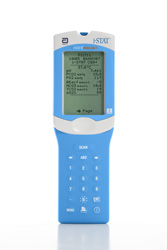

is an indirect distributor of the Abbott iStat products.
#ISTAT BLOOD GAS PORTABLE#
It is portable, reliable, and includes these important features:Ĭartridges are self-contained and the system is simple to learn and operateĪdvanced biosensor technology and real time quality assurance provides extremely accurate testingĭISCLAIMER: CLIAwaived Inc. To describe the use of the i-STAT system portable handheld blood analyzer used to analyze whole blood for blood gas, chemistry, and coagulation at the point of. Utilizing self-contained test cartridges, along with the Precision PCx™ and PCx Plus™ glucose test strips, the i-STAT 1 system delivers lab-accurate testing for Blood Gases, Electrolytes, Chemistries, Coagulation, Hematology, Glucose, and Cardiac Markers (cTnI). Cartridge, Blood Gas and Electrolytes i-STAT EC4+ Sodium, Potassium, Glucose, Hematocrit, Hemoglobin For i-STAT Handheld Blood Analyzer Abbott Point of Care. diffuses through a gas permeable membrane from the blood sample into an. The i-STAT® 1 handheld system performs a comprehensive panel of critical tests. Blood Gases (pH, PCO2, PO2, Lac, HCO3, TCO2, BE, sO2) We will use CG4+ cartridges for blood gas testing, clearly marked on the cartridge Prior to using a cartridge, it must be removed from refrigerated storage and kept at room temperature in its protective pouch for at least 5 minutes for best results until it attains room temperature. The i-STAT System delivers quantitative laboratory results on a small sample of. congenital defects in the heart or shunting of venous blood into the arterial system without oxygenation in the lungs). bronchitis, emphysema, or pulmonary edema), and alteration in the flow of blood within the heart or lungs (e.g. This revolutionary, handheld analyzer provides reliable test results in just minutes, using as little as two drops of blood and a test cartridge. With i-STAT G3+, healthcare professionals can obtain blood gases in approximately two minutes at the bedside, allowing care teams to accelerate patient-care decisions. obstruction or trauma to the brain), impaired gas exchange between alveolar air and pulmonary capillary blood (e.g.



 0 kommentar(er)
0 kommentar(er)
